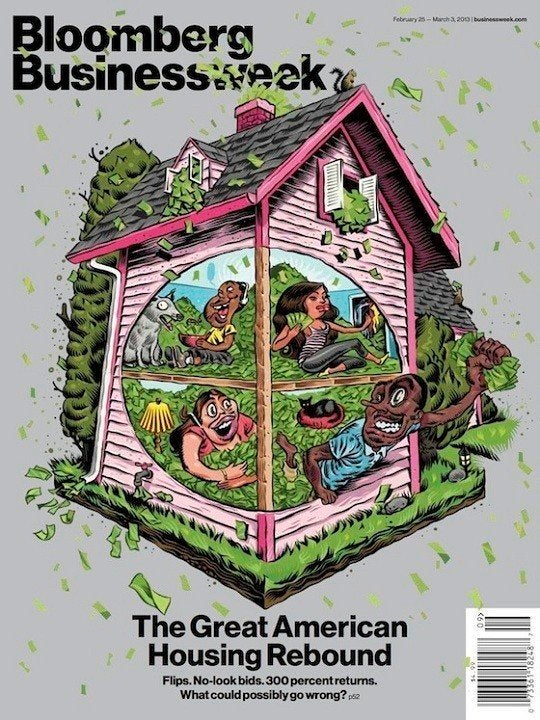
A recent issue of Bloomberg Businessweek announced the strengthening of the housing market with a cover that was as misleading as it was unseemly. Under the headline "The Great American Housing Rebound: Flips. No-look bids. 300 percent returns. What could possibly go wrong?", the cover portrayed a house overflowing with cash and filled with grossly caricatured people of color reveling inside it. In contrast, the connected story was tame, and discussed the strengthening housing market in Phoenix, Ariz., with no mention of racial minorities. The cover blames people of color for the financial crisis, a long-standing trope that portrays borrowers of color as having caused the crisis because they supposedly took out loans they knew they could never repay. It's a story that gives comfort to some. The only thing wrong with it is that it has no basis in fact.
But the Businessweek editors are not alone in perpetuating this myth, or others like it. For example, a recent study by the National Bureau of Economic Research (NBER), a non-governmental, non-partisan organization, attempts to lay blame for the risky lending that led to the financial crisis at the feet of the Community Reinvestment Act (CRA), another favorite whipping boy of the minorities-caused-the-financial-crisis camp. The CRA, the story goes, forced banks to make risky loans to borrowers of color; when these loans inevitably went belly up, they set off the financial crisis.
A product of the Civil Rights era, the CRA, by its express terms, asks bank regulators to do no more than "encourage" banks to meet the needs of low- and moderate-income communities, consistent with safe and sound banking practices. Banks periodically undergo CRA exams by their regulators to ensure that they are meeting the law's goals. Regulators have long given high marks to the overwhelming majority of banks covered by the law; indeed, 98 percent of banks in the mid-2000s received passing CRA grades.
As for the relationship between the CRA and the financial crisis, the CRA is fairly narrow in scope. It does not apply to stand-alone mortgage lenders, which is why most subprime lenders during the height of the market were beyond its reach. It also does not even apply to lending by banks otherwise covered by the CRA when they act outside of their "CRA assessment areas": i.e., where they have branches or engage in a substantial amount of lending. As research from the Board of Governors of the Federal Reserve shows, the CRA covered just 6 percent of subprime lending during the height of the subprime mortgage frenzy.
The NBER researchers argue that their study reveals that the CRA helped lead to riskier lending in the mid-2000s. As a result, some have latched on to this claim to revive the argument that the CRA, by supposedly "forcing" banks to lend to communities of color, pressured innocent banks to lend to people who were not fit to be homeowners.
While the Businessweek cover "art" is an example of grotesque know-nothingness, the NBER study strives to be a scholarly work and deserves some attention, and a response. The study looked at lending between 1999 and 2009 and attempted to determine whether there was any difference in the lending decisions by banks undergoing exams and those not. It also looked at the performance of the loans made by both types of banks: examined and unexamined banks. It found an increase in loan approval rates by banks undergoing a CRA exam. It also found a slight increase in delinquency rates of the loans made by banks undergoing an exam.
The study had several significant methodological flaws, however, which are explored in greater depth here. While many communities may be covered by the CRA because of their economic profile, not all such communities are located in a particular bank's CRA assessment areas. The NBER researchers assumed that any lending in low- or moderate-income communities was covered by the CRA, but that is not the case. In fact, by asserting that loan approval rates in low- and moderate-income communities increased slightly in the shadow of the CRA, without ensuring that the loans approved were actually covered by the CRA, it is hard to conclude that the NBER research revealed any CRA effect. In fact, it is quite possible that what the researchers actually uncovered was that the loan application rate increased outside the CRA, but in low- and moderate-income communities nonetheless. Accepting that the loans extended were riskier when made by banks undergoing exams, it is quite possible that what the researchers found is that banks engaged in riskier lending outside of their CRA assessment areas, and thus beyond the scope of the CRA. Such a finding would be consistent with other research by the Federal Reserve of bank practices during the height of the mortgage market that showed just that: lending in bank CRA assessment areas was generally far better in quality than lending outside of them.
Furthermore, the NBER study attempted to show that lending by banks undergoing CRA exams was riskier than banks not being examined. Here, they identify a higher 90-day delinquency rate for loans made by banks undergoing a CRA exam. They point to an increase in the delinquency rate, but also admit that this increase was slight overall; banks undergoing exams had a serious delinquency rate of 1.6 percent, but loans by banks not undergoing such an exam had a delinquency rate of just 1.2 percent. Even assuming all loans identified in the research were within the respective banks' CRA assessment areas, when compared to the serious delinquency rate of loans during the height of the foreclosure crisis -- nearly 10 percent -- one can see that the performance of loans covered by the CRA was far better than that of many loans in the country. Given that, it is hard to conclude that the CRA caused the crisis, when, even accepting the NBER study at face value, the delinquency rate of CRA-related lending was far less than the national average.
Those who tend the flame of prejudice by looking to blame communities of color and government policies like the CRA for the financial crisis find solace in the NBER report, and were probably amused by the Bloomberg Businessweek cover that reflected their sympathies. But neither can withstand any serious scrutiny. A fair reading of the facts reveals that lending in communities of color was indeed heightened in the lead up to the financial crisis, but this is because traditional lenders had historically failed to serve such communities. Predatory lenders took advantage of such communities and disproportionately sold their wares there. They masked the true costs of the loans they were selling, and told prospective borrowers that they could always refinance their mortgages before adjustable rates kicked in; property values only go up, after all. Subprime lenders then packaged their loans as securities with little regard for how those loans would perform.
Much of this happened outside the protections of the CRA, however. Blaming the victims of such behavior does little more than shield the perpetrators of predatory conduct from serious scrutiny. Tragically, by continuing to perpetuate these memes, time passes and memories fade, and the true culprits are not held accountable for their actions.
